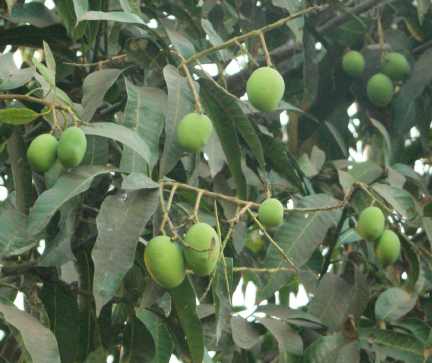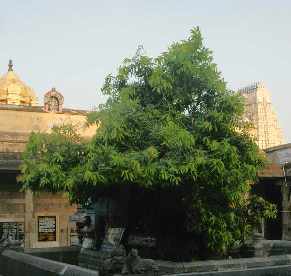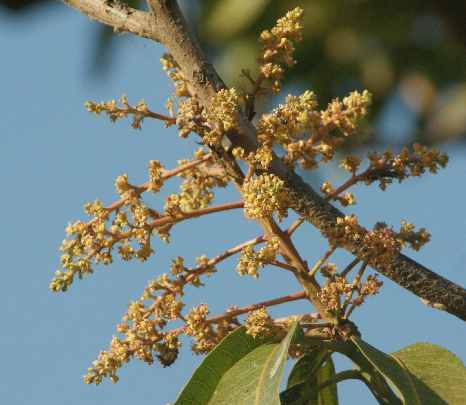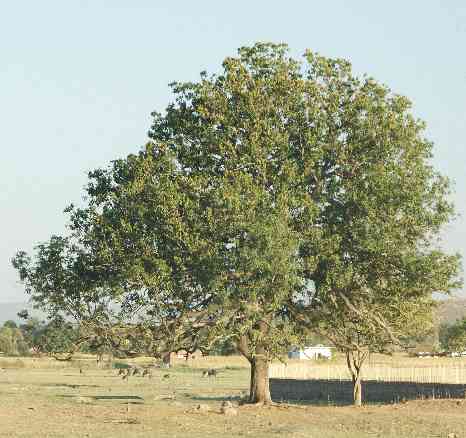
|
| Mango tree |
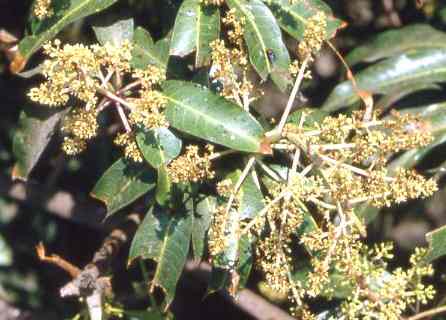
|
| Mango flower |
It is, though, surprising and not much known that the unripe fruit gives a remarkable spice much used in Northern India (but, to my knowledge, nowhere else).
The stone removed, the fruit is cut in slices, dried and afterwards ground to a pale gray powder. This powder is used frequently instead of tamarind, the other important sour element in Indian cuisine; mango powder is, however, much weaker than tamarind and has a subtle, resin-like taste. It is mainly used when only a hint of tartness is desired or when the dark brown colour of tamarind is to be avoided. Mango powder is generally more popular with vegetables than with meat, but is frequently found in tikka [टिक्का] spice mixtures for barbecued meat.
To prepare the famous
barbecued meat of Northern Indian cuisine, an Indian clay
oven (tandoor [तन्दूर]) is required, but substitution by a Western
baking oven is acceptable. Meat to be grilled is seasoned with a mixture of
several spices (cumin, coriander, fresh ginger
and garlic and mango powder, but little or no chiles) with red food colouring and plain yoghurt.
After some hours, it is quickly roasted in the very hot tandoor. Mango powder here serves not only as a tart and sour
spice, but also as a meat tenderizer.
| ||
|
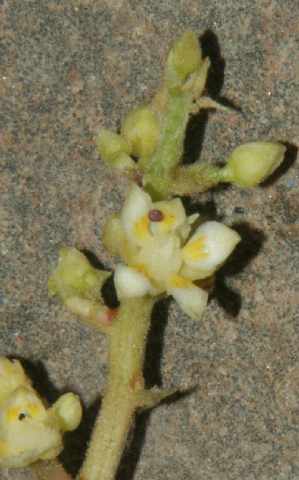
|
| Mango flower |
Pickled unripe mangoes are a common Indian condiment (aam ka achar [आम का अचार]) that is served all over North India, particularly together with simple meals of rice and cooked legumes (dal [दाल]). The best varieties are prepared using pungent Bengali mustard oil. Its South Indian sibling, avakaya [ఆవకాయ] from Andhra Pradesh, is dark red due to excessive amounts of chile, and derives additional pungency from untoasted, ground mustard seeds. In Karnataka, a similar pickle is called mavina uppinakayi [ಮಾವಿನ ಉಪ್ಪಿನಕಾಯಿ].
A pickle similar to aam achar but made from ripe mangoes and much less oily (amba [عمبه]), is eaten in Iraq, where it is also processed into a coarse sauce that goes well with grilled meats (shawarma [شاورما]). Due to Iraqi Jew immigrants, this has also become quite popular in Israel (ambah [עמבה]) for chickpea balls falafel [פלאפל] and broiled meat shawarmah [שווארמה].
Ripe mangos are a popular fruit and may be used for stewed fruits, fruit jam, fruit cakes and many other standard fruit applications; they can, however, even used for savoury dishes. Indonesian fruit salad (rujak) combines fresh fruits (not too ripe mango, pineapple, papaya, in Jawa frequently cucumber) with a pungent sauce of palm sugar (won from coconut or other palm trees), fresh red chiles and salt; on Bali, a hint of shrimp paste (trassi, see also Indonesian bay-leaf on Balinese cookery) is never omitted. The result tastes even more delicious that the recipe looks strange!
Mexicans sometimes use ripe mangoes or other tropical fruits for their fiery salsas (see long coriander). Even if it is hard to believe, the extremely hot habanero chile goes very well with fruit aroma.
Several other plants are used to give a sour (tart or fresh) taste to the food;
it is convenient to distinguish between fruity, sweet–sour plants on one hand
and purely sour spices on the other hand. In the first class, besides ripe
mangoes orange and pomegranates and other ripe fruit must be mentioned.
Greater importance, however, must be attributed to the representatives of the
second class.
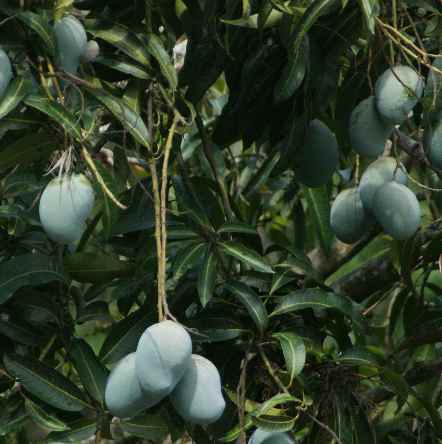
|
| Despite their blueish hue, these mangos are ripe! |

|
| Mango fruits on tree |
Among these, lemon is probably the most important and extensively used in Latin America and the Eastern Mediterranean region (where also sumac is common). In the tropics, lemon is outweighted by a close relative, lime, which has a most refreshing acidic flavour. Lime is indispensable in the cuisines of tropical America (parts of México and the Caribbean) and Asia (Thailand, Indonesia, Philippines, India); in contrast, kaffir lime is important as a source of citrus-like aroma, but not acidic flavour. Another essential sour ingredient throughout the tropics and subtropics is tamarind; its acidity is well balanced (neither pungent nor astringent) and is particularly suited for spicy or even fiery food.
When speaking about sour food additives, vinegar (though not a spice) should
not be forgotten; made from various alcoholic sources (palm wine, rice wine, brandy, fruit wines, mostly
from grapes or apples; industrially the most common source is wood), it is
known and held in favour all over the world. Depending on source material,
manufacturing process and storage, vinegar may be monodimensionally acidic (as
white South East Asian rice vinegar or the industrial vinegar sold in Western countries),
or mild (as with coconut vinegar),
or it may develop a complex, rich and
wonderful taste like the famous and rightfully high priced aceto
balsamico (balm vinegar) from the Italian town Modena, which is aged for
years in open barrels of fragrant wood. See dill
on the topic of herb-flavoured vinegar.


